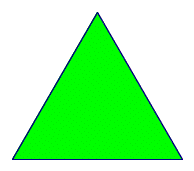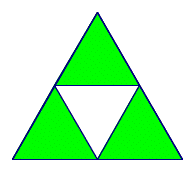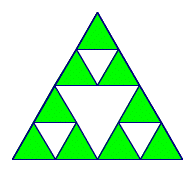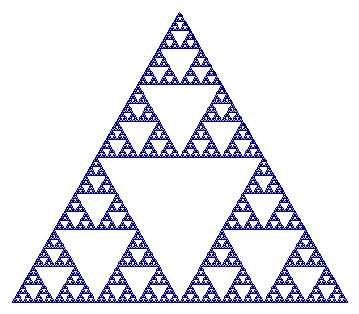We are studying self-similar fractals right now.
On the next quiz, you will be asked to do the following thing for one or two fractals:
1. Draw out the next iteration, after you have been shown the first 2 or 3 iterations.
2. Make a table and figure out a formula for the length of a fractal.
3. Circle a part or parts that are similar to the whole (but are smaller than the whole)
Sample problems:
1. This fractal rule for the fractal Cantor dust is: take out the middle third or each segment in the previous iteration.
A. Draw the next iteration of the fractal
| iteration 0 | |
| iteration 1 | |
| iteration 2 |
B. Complete the table below, and explain your rule for finding the numbers that go in the table
| iteration number | number of pieces | length of each piece | total length |
| 0 | 1 | 1 m. | 1 m. |
| 1 | |||
| 2 | |||
| 3 |
2. The fractal rule for the Koch curve is to replace each segment with a new shape (shown below) which is formed by erasing the middle third, and putting in two segments that would make an equilateral triangle in its place:
Segment was: |
Changed to: |
 |
A. Draw the next iteration:
| iteration 0 | |
| iteration 1 |  |
| iteration 2 |  |
B. Complete the table below, and explain your rule for finding the numbers that go in the table
| iteration number | number of pieces | length of each piece | total length |
| 0 | 1 | 1 | 1 |
| 1 | |||
| 2 | |||
| 3 |
3. In this Koch curve, circle a piece that is the same shape as the whole curve.

4. The fractal rule for the Sierpinski triangle is to replace each (point up) triangle with a new shape (shown below) which is formed by connecting the midpoints of its sides, and erasing the middle, leaving 3 smaller triangles:
triangle was |
Changed to: |
 |
 |
A. Draw the next iteration:
| iteration 0 |  |
| iteration 1 |  |
| iteration 2 |  |
B. Complete the table below, and explain your rule for finding the numbers that go in the table
| iteration number | number of sements | length of each segment | total length |
| 0 | 3 | 1 m | 3 |
| 1 | |||
| 2 | |||
| 3 |
C. Circle a piece that is the same shape (but smaller) as the whole shape.
